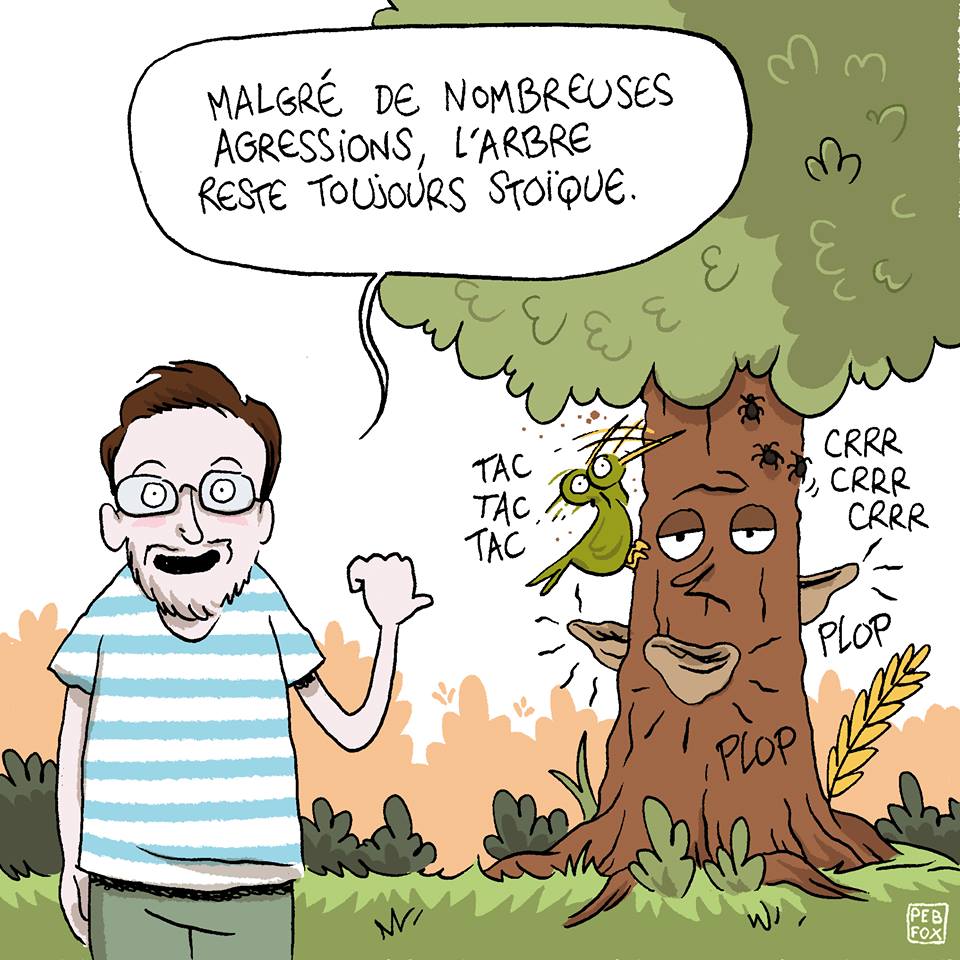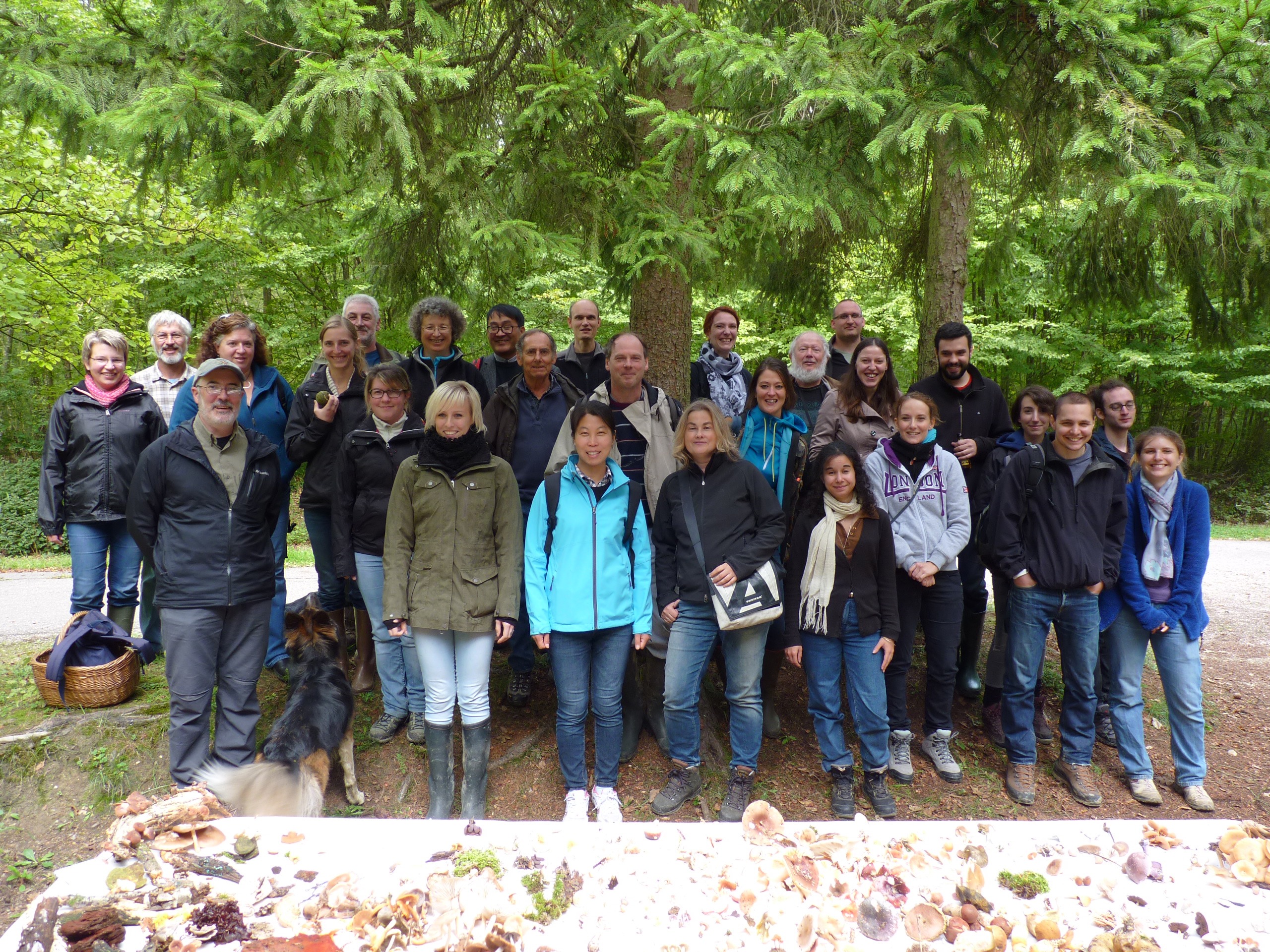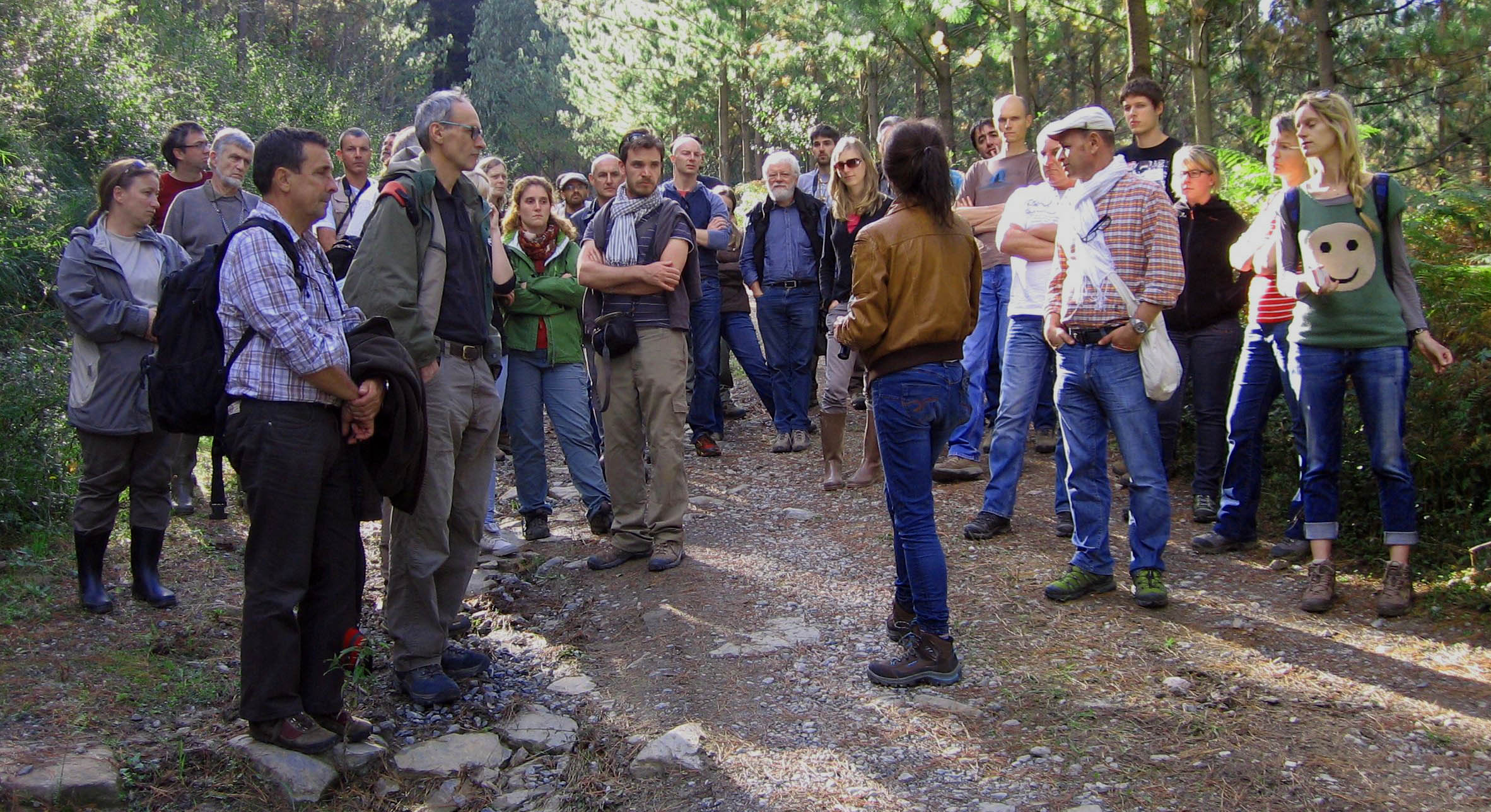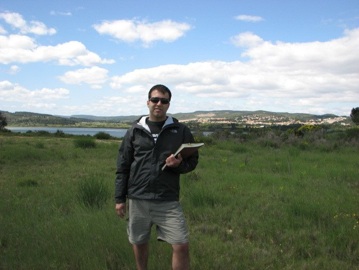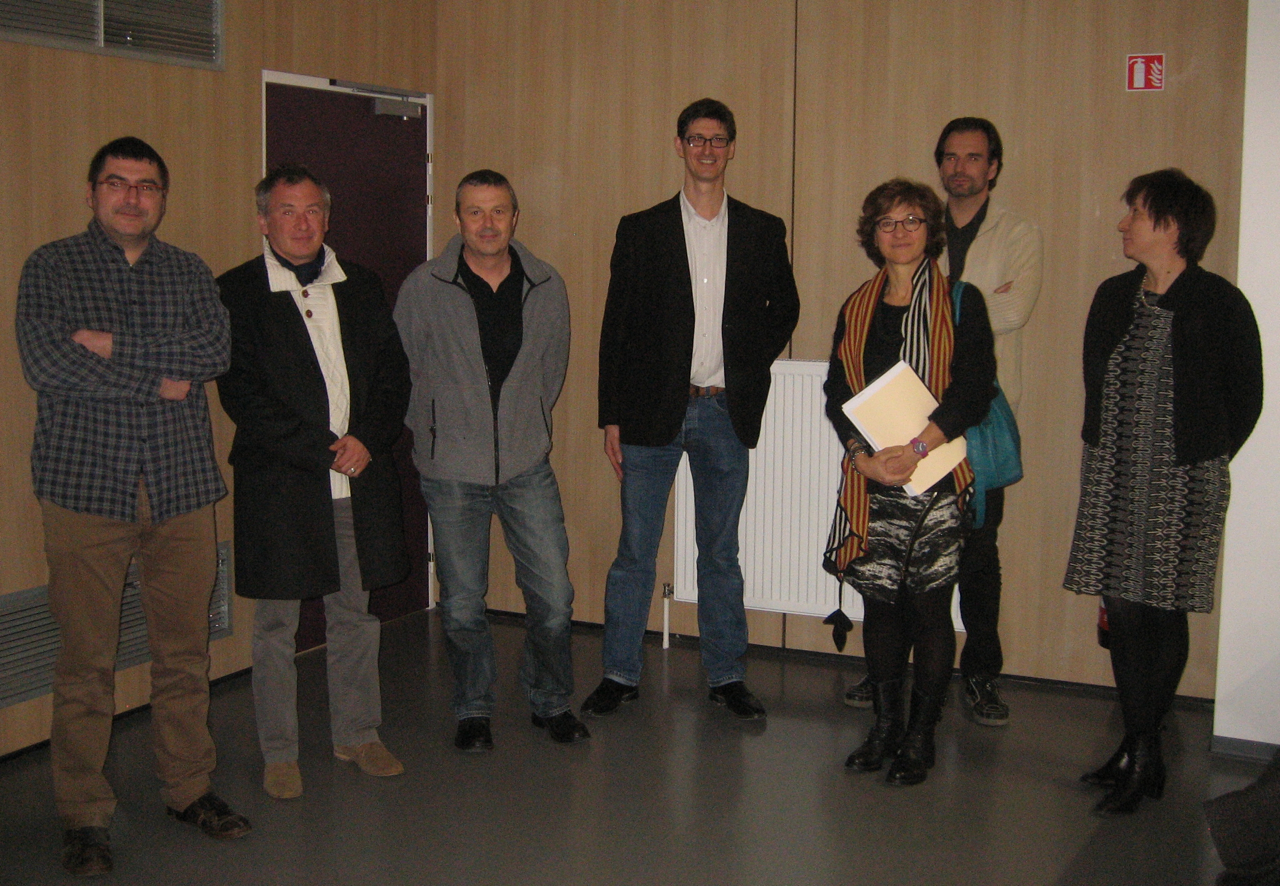English version: see below
Titre du sujet de thèse :
Architecture génétique de traits d’histoire de vie liés au pouvoir pathogène de l’agent de la rouille du peuplier.
Encadrants :
Pascal FREY (DR2, HDR), directeur de la thèse
Fabien HALKETT (CR1), co-encadrant
Stéphane DE MITA (CR2), co-encadrant
Laboratoire d’accueil :
UMR Interactions Arbres – Microorganismes
INRA/Université de Lorraine
Centre INRA Nancy-Lorraine
54280 Champenoux
Université d’inscription de l’étudiant en thèse : Université de Lorraine
Ecole doctorale : RP2E (Ressources, Procédés, Produits, Environnement)
Financement (acquis) : INRA Département EFPA (Ecologie des Forêts, Prairies et milieux Aquatiques) & Région Lorraine
Résumé de la thèse
L’objectif de la thèse est d’étudier l’architecture génétique de traits d’histoire de vie liés au pouvoir pathogène de l’agent de la rouille du peuplier, Melampsora larici-populina. Nous faisons l’hypothèse que l’agressivité du champignon risque d’augmenter suite au déploiement au champ de nouveaux cultivars de peuplier portant des résistances quantitatives. L’objectif général de cette thèse est de mieux comprendre le potentiel d’évolution de l’agressivité des agents pathogènes, afin d’alimenter la réflexion sur les stratégies de sélection de résistances durables, en particulier chez le peuplier.
Contexte et enjeux
Le peuplier constitue une production importante en Europe pour le bois d’industrie et sa contribution à des filières énergétiques est en nette progression. La rouille du peuplier, causée par le champignon pathogène Melampsora larici-populina constitue la principale contrainte phytosanitaire de la populiculture en Europe et dans le monde. La sélection de variétés de peupliers résistants à la rouille était basée pendant des décennies sur la sélection d’hybrides F1 interspécifiques, portant majoritairement des résistances qualitatives monogéniques et dominantes, basées sur la relation gène-pour-gène. Cependant, les déploiements successifs au champ de cultivars de peuplier à résistances qualitatives se sont soldés par les contournements systématiques de ces résistances par l’agent pathogène, témoignant de leur caractère non durable à moyen et long terme (Xhaard et al., 2011). La connaissance du déterminisme génétique des facteurs de virulence qui causent les contournements de résistance serait souhaitable, tant sur le plan fondamental (interactions entre loci d’avirulence et loci de résistance) que sur le plan appliqué (stratégies de gestion spatio-temporelle des résistances qualitatives).
Depuis une vingtaine d’années, la recherche de résistances plus durables a conduit les améliorateurs à s’orienter vers la sélection de résistances quantitatives, à déterminisme génétique plus complexe. Cependant, la résistance quantitative peut également s’éroder du fait de l’augmentation de l’agressivité des agents pathogènes, définie comme la composante quantitative du pouvoir pathogène (Pariaud et al., 2009). Par conséquent, il est primordial d’étudier l’évolution potentielle des traits d’agressivité et leurs éventuels compromis évolutifs (Lannou, 2012).
De plus, la sélection de traits favorables peut conduire à des trade-offs, c’est-à-dire des compromis entre traits d’histoire de vie (Laine & Barrès, 2013). Les trade-offs entre traits peuvent refléter des stratégies d’adaptation de l’agent pathogène à l’hôte (compétition et/ou dispersion) suivant les traits sur lesquels les individus investissent prioritairement (Pariaud et al., 2009) et peuvent donc jouer un rôle primordial au cours des processus épidémiques. L’étude de ces trade-offs entre traits quantitatifs peut ainsi permettre de mieux comprendre les paramètres qui conditionnent une épidémie.
Hypothèses de travail et objectifs de la thèse
L’hypothèse principale est que l’agressivité de M. larici-populina pourrait augmenter suite au déploiement de nouveaux cultivars de peuplier portant des résistances quantitatives. Par conséquent, une connaissance de l’architecture de ces traits et de leurs trade-offs éventuels devrait permettre d’orienter les stratégies de sélection pour des résistances durables (McDonald & Linde, 2002).
L’objectif central de la thèse proposée est d’étudier l’architecture génétique des traits d’histoire de vie qualitatifs (facteurs de virulence) et quantitatifs (composantes d’agressivité) chez l’agent de la rouille du peuplier. Pour cela, les techniques de NGS (Next Generation Sequencing) seront utilisées.
Les objectifs détaillés de ce projet de thèse seront :
- de cartographier les facteurs de virulence et les QTL d’agressivité par une approche de re-séquençage de descendances (autofécondations et allofécondations) obtenues par croisements contrôlés de M. larici-populina (Pernaci et al., 2014 ; Pernaci 2015).
- de cartographier ces mêmes traits qualitatifs et quantitatifs par une approche de GWAS (Genome-Wide Association Study ; Hamblin et al., 2011) sur des populations naturelles de M. larici-populina.
- d’étudier les compromis évolutifs (trade-offs) entre ces traits, qui peuvent conditionner l’adaptation de M. larici-populina aux résistances du peuplier.
Publications récentes des responsables de la thèse, en rapport avec le projet proposé :
Pernaci, M., De Mita, S., Andrieux, A., Pétrowski, J., Halkett, F., Duplessis, S., and Frey, P. (2014). Genome-wide patterns of segregation and linkage disequilibrium: the construction of a linkage genetic map of the poplar rust fungus Melampsora larici-populina. Frontiers in Plant Science 5, 454.
Persoons, A., Morin, E., Delaruelle, C., Payen, T., Halkett, F., Frey, P., De Mita, S., and Duplessis, S. (2014). Patterns of genomic variation in the poplar rust fungus Melampsora larici-populina identify pathogenesis-related factors. Frontiers in Plant Science 5, 450.
Barrès, B., Dutech, C., Andrieux, A., Halkett, F., and Frey, P. (2012). Exploring the role of asexual multiplication in poplar rust epidemics: impact on diversity and genetic structure. Molecular Ecology 21, 4996-5008.
Xhaard, C., Barrès, B., Andrieux, A., Bousset, L., Halkett, F., and Frey, P. (2012). Disentangling the genetic origins of a plant pathogen during disease spread using an original molecular epidemiology approach. Molecular Ecology 21, 2383-2398.
Xhaard, C., Fabre, B., Andrieux, A., Gladieux, P., Barrès, B., Frey, P., and Halkett, F. (2011). The genetic structure of the plant pathogenic fungus Melampsora larici-populina on its wild host is extensively impacted by host domestication. Molecular Ecology 20, 2739-2755.
Autres références bibliographiques
Hamblin, M.T., Buckler, E.S., and Jannink, J.L. (2011). Population genetics of genomics-based crop improvement methods. Trends Genet 27, 98-106.
Laine, A.L., and Barrès, B. (2013). Epidemiological and evolutionary consequences of life-history trade-offs in pathogens. Plant Pathology 62, 96-105.
Lannou, C. (2012). Variation and selection of quantitative traits in plant pathogens. Annual Review of Phytopathology 50, 319-338.
McDonald, B.A., and Linde, C. (2002). Pathogen population genetics, evolutionary potential, and durable resistance. Annual Review of Phytopathology 40, 349-379.
Pariaud, B., Ravigné, V., Halkett, F., Goyeau, H., Carlier, J., and Lannou, C. (2009). Aggressiveness and its role in the adaptation of plant pathogens. Plant Pathology 58, 409-424.
Pernaci, M. (2015). Etude des traits d’histoire de vie de Melampsora larici-populina, agent de la rouille du peuplier : de leur déterminisme génétique à leurs conséquences évolutives. Thèse de Doctorat, Université de Lorraine, 200 p.
Candidature :
Envoyer un CV, une lettre de motivation et les coordonnées de 2 personnes de référence à Pascal Frey (pascal.frey@nancy.inra.fr) avant le 1er octobre 2015.
Compétences recherchées
Le(la) candidat(e) devra avoir de bonnes compétences en génétique (génétique quantitative, génétique des populations, génomique) et en bioinformatique. Il(elle) devra avoir des connaissances de base en écologie et un intérêt pour la biologie évolutive et la pathologie végétale. Un goût prononcé pour le travail en équipe est indispensable.
————————————————————————————————-
Title of the thesis
Genetic architecture of pathogenicity-associated life history traits in the poplar rust fungus.
Advisors:
Pascal FREY (Senior scientist), main supervisor
Fabien Halkett (Junior scientist), co-supervisor
Stéphane DE MITA (Junior scientist), co-supervisor
Host laboratory
Department of Tree – Microbe Interactions
INRA / University of Lorraine
INRA Nancy-Lorraine Research Centre
54280 Champenoux
Funding (acquired): INRA EFPA Scientific division (Ecology of Forests, Grasslands and Aquatic environments) & Region Lorraine. Duration 3 years. Monthly net salary about €1400.
Thesis summary
The aim of the thesis is to study the genetic architecture of life history traits related to pathogenicity in the poplar rust fungus, Melampsora larici-populina. We assume that the aggressiveness of the fungus may increase following the deployment in the field of new poplar cultivars with quantitative resistance. The general objective of this thesis is to better understand the potential evolution of aggressiveness in pathogens, to fuel the debate on sustainable resistance breeding strategies, especially in poplar.
Context and challenges
Poplar is an important product for the wood industry worldwide and its contribution to energy systems has increased recently. Poplar rust, caused by the pathogenic fungus Melampsora larici-populina, is the main phytosanitary constraint for commercial poplar cultivation in Europe and worldwide. In the last 50 years many rust-resistant cultivars were bred and released, but each of the qualitative resistance genes (i.e. major resistance genes) released have been overcome by pathogen evolution within a short period (Xhaard et al., 2011). Qualitative resistance is particularly subject to breakdown by pathogen evolution for perennial hosts, such as poplar trees, because of the wide inequality between the pathogen’s rapid generation time and the time needed to deploy new host varieties. Knowledge of the genetic determinism of the virulence factors leading to resistance breakdown would be beneficial both from an academic perspective (e.g. to decipher interactions between avirulence loci and resistance loci) and from an applied perspective (e.g., for determining strategies of spatiotemporal management of qualitative resistance).
The failure of qualitative resistances to control poplar rust has prompted breeders to search for quantitative resistance, which is supposed to be more durable. However quantitative resistance can also be challenged by the evolution of aggressiveness, which is the quantitative component of pathogenicity, determined by several disease-associated traits (Pariaud et al., 2009). Thus it is of primary importance to assess the potential evolution of aggressiveness traits in the pathogen and the potential trade-offs between these traits (Lannou, 2012; Laine & Barrès, 2013).
Working hypotheses and objectives of the thesis
The main hypothesis is that the aggressiveness of M. larici-populina could increase following the deployment of new poplar cultivars with quantitative resistance. Therefore, knowledge of the architecture of aggressiveness traits and their potential trade-offs would be useful in order to guide breeding strategies towards durable resistance (McDonald & Linde, 2002).
The central aim of the proposed thesis is to study the genetic architecture of qualitative (virulence factors) and quantitative (aggressiveness components) traits in the poplar rust fungus. To this aim, whole-genome re-sequencing techniques will be used.
The detailed objectives of this PhD project will be:
- To map avirulence loci and aggressiveness QTLs through whole-genome re-sequencing of selfed and/or outcrossed progenies obtained from controlled crosses of M. larici-populina (Pernaci et al, 2014; Pernaci 2015).
- To map the same kind of qualitative and quantitative traits through an approach of Genome-Wide Association Study (GWAS; Hamblin and al., 2011) in natural populations of M. larici-populina.
- To assess the potential trade-offs between those traits, which can condition the adaptation of the pathogen to the resistance of the host.
Recent publications of the thesis advisors in relation to the proposed project
Pernaci, M., De Mita, S., Andrieux, A., Pétrowski, J., Halkett, F., Duplessis, S., and Frey, P. (2014). Genome-wide patterns of segregation and linkage disequilibrium: the construction of a linkage genetic map of the poplar rust fungus Melampsora larici-populina. Frontiers in Plant Science 5, 454.
Persoons, A., Morin, E., Delaruelle, C., Payen, T., Halkett, F., Frey, P., De Mita, S., and Duplessis, S. (2014). Patterns of genomic variation in the poplar rust fungus Melampsora larici-populina identify pathogenesis-related factors. Frontiers in Plant Science 5, 450.
Barrès, B., Dutech, C., Andrieux, A., Halkett, F., and Frey, P. (2012). Exploring the role of asexual multiplication in poplar rust epidemics: impact on diversity and genetic structure. Molecular Ecology 21, 4996-5008.
Xhaard, C., Barrès, B., Andrieux, A., Bousset, L., Halkett, F., and Frey, P. (2012). Disentangling the genetic origins of a plant pathogen during disease spread using an original molecular epidemiology approach. Molecular Ecology 21, 2383-2398.
Xhaard, C., Fabre, B., Andrieux, A., Gladieux, P., Barrès, B., Frey, P., and Halkett, F. (2011). The genetic structure of the plant pathogenic fungus Melampsora larici-populina on its wild host is extensively impacted by host domestication. Molecular Ecology 20, 2739-2755.
Other references
Hamblin, M.T., Buckler, E.S., and Jannink, J.L. (2011). Population genetics of genomics-based crop improvement methods. Trends Genet 27, 98-106.
Laine, A.L., and Barrès, B. (2013). Epidemiological and evolutionary consequences of life-history trade-offs in pathogens. Plant Pathology 62, 96-105.
Lannou, C. (2012). Variation and selection of quantitative traits in plant pathogens. Annual Review of Phytopathology 50, 319-338.
McDonald, B.A., and Linde, C. (2002). Pathogen population genetics, evolutionary potential, and durable resistance. Annual Review of Phytopathology 40, 349-379.
Pariaud, B., Ravigné, V., Halkett, F., Goyeau, H., Carlier, J., and Lannou, C. (2009). Aggressiveness and its role in the adaptation of plant pathogens. Plant Pathology 58, 409-424.
Pernaci, M. (2015). Etude des traits d’histoire de vie de Melampsora larici-populina, agent de la rouille du peuplier : de leur déterminisme génétique à leurs conséquences évolutives. Thèse de Doctorat, Université de Lorraine, 200 p.
Application
Send CV, cover letter and contact details of two referees to Pascal Frey (pascal.frey@nancy.inra.fr) before 1 October 2015.
Required skills
The candidate should have good skills in genetics (quantitative genetics, population genetics, genomics) and bioinformatics. He/she should have basic knowledge in ecology and an interest in evolutionary biology and plant pathology. A taste for teamwork is essential. Knowledge of French will be an asset but is not mandatory.
